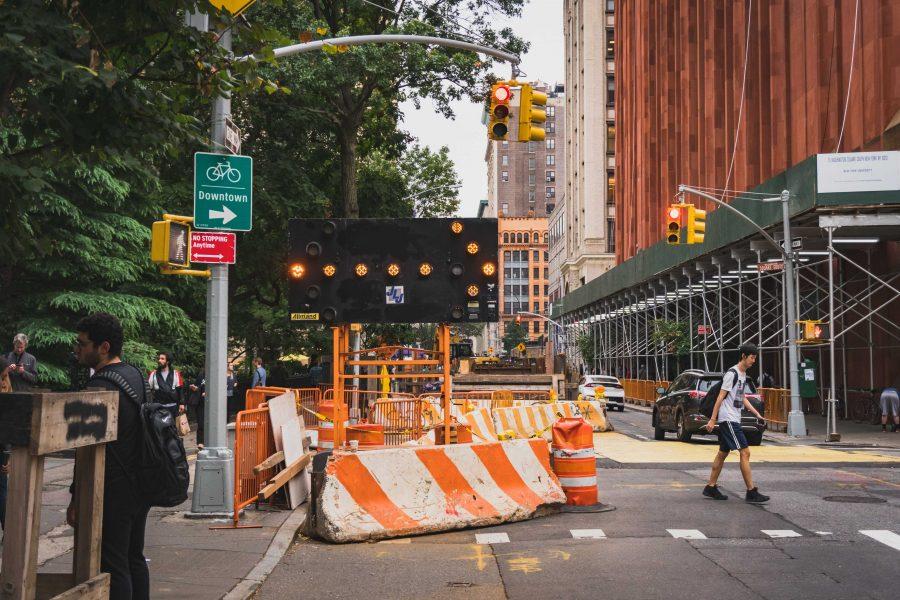It’s a Thursday morning, and you’re rushing to your 10 a.m. Writing the Essay class. The trip typically takes 15 minutes, and you left at 9:50 a.m. after securing your morning cup of joe. You skirt around the hordes of slow tourists and reach the end of the block. The traffic light glows with the dreaded red hand, but the next car is at least seven seconds away, and it only takes you four to cross. You speed over the crosswalk, managing to avoid the oncoming Toyota. You make it to class unscathed with 30 seconds to spare, slide into your chair and take a victorious sip of coffee.
To most New Yorkers, jaywalking is second nature, an essential part of navigating the city’s crowded streets. Even though it is technically illegal — an unlucky few have been fined $250 for jaywalking — one would be hard-pressed to find a New York native who waits for the walk signal.
However, in Los Angeles, pedestrians abide by traffic laws in fear of receiving a ticket. The LAPD doles out “tens of thousands of tickets every year,” reports the Village Voice, while the NYPD only issued an average of 450 tickets per year between 2008 and 2015.
After moving from LA to New York City, Steinhardt junior Gina Puccinelli noticed differences between the cities’ jaywalking attitudes. “Jaywalking is very much not the culture of LA,” Puccinelli said, citing her hometown’s fewer pedestrians and more cars as a potential reason for increased police awareness.
Puccinelli, who has seen LA police ticket jaywalkers, initially felt nervous about breaking traffic laws, especially in front of New York’s finest. However, she has adjusted to New York City’s caution-to-the-wind attitude and now jaywalks with confidence.
She attributes the city’s jaywalking habits to its frenetic energy. “There’s also the constant rush aspect that is very prevalent here that is very, very different than LA,” Puccinelli said.
Queens native and Tandon sophomore Aadiba Haque also credits New Yorkers’ go-getter spirit as a reason for jaywalking.
“Jaywalking has become New York culture, and I think it’s because New Yorkers are so fast-paced all the time,” Haque said. “We’re always in a rush and have places to be.”
Another native New Yorker, LS sophomore Crystal Chu of Staten Island, theorizes that New York City cops are lenient about jaywalking because it is not detrimental to the economy like the oft-ticketed subway fare evaders. She has never seen anyone get ticketed for jaywalking, and does not believe that the NYPD should enforce these laws.
Given the sheer amount of New Yorkers who jaywalk, Chu believes it would be a waste of energy.
“Focusing on ticketing jaywalkers is not efficient nor highly accurate,” she said.
However, it isn’t always the case jaywalking does little harm. While statistics about responsibility for pedestrian deaths are still being debated, efforts have been made to reduce these incidents. In January 2014, Mayor Bill de Blasio initiated a Vision Zero plan, which aims to reduce traffic-related injuries and deaths. That same month, three pedestrians were killed on the Upper West Side in a span of nine days. To prevent further incidents, NYPD stepped up their traffic law enforcement in the neighborhood.
This initiative went awry when an 84-year-old man was hospitalized that month for a head wound inflicted by police attempting to ticket him for jaywalking. If the NYPD was looking to inspire public support for anti-jaywalking enforcement, images of the man’s bloodied forehead in the news likely sabotaged it.
Given that New Yorkers still jaywalk when and where they please, it seems like the NYPD’s attempts to bust these rule-breakers will remain at a minimum. After all, jaywalking is ingrained in New Yorkers, and that doesn’t seem to be changing anytime soon.
Email Lauren Gruber at [email protected].























































































































































